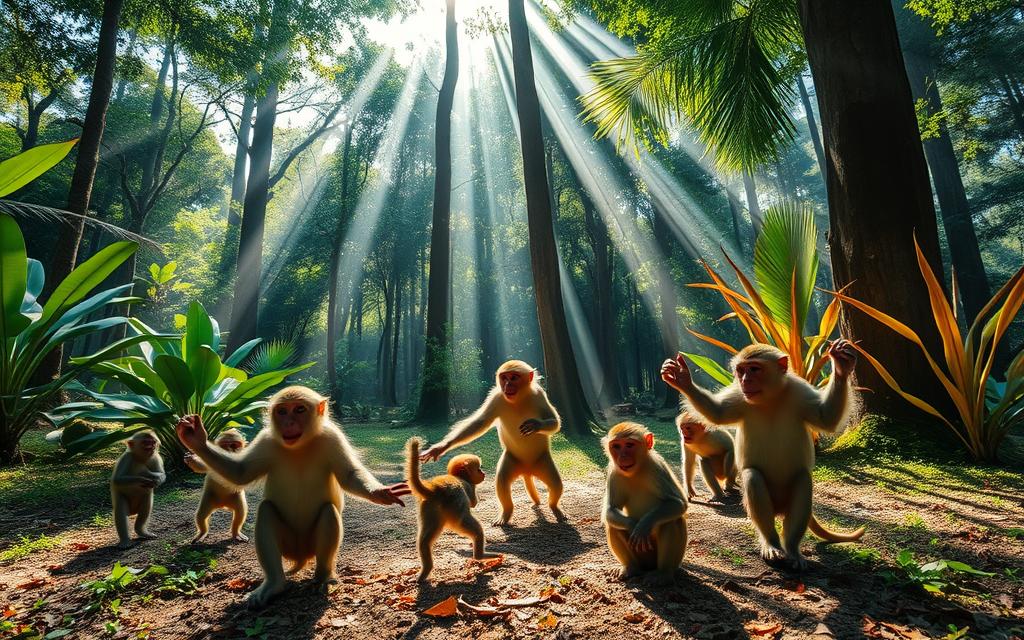
Sacred Monkey Forest: Bali’s Eco-Tourism Gem
Did you know the Sacred Monkey Forest gets over 10,000 visitors every month? It’s a special place in Ubud, Bali, covering 12.5 hectares. It’s home to about 700 Balinese long-tailed macaques and has around 186 tree species12. The forest is not just beautiful; it’s also spiritual. It has ancient temples that attract those looking for adventure and wisdom.
This place focuses on eco-friendly tourism. It makes sure the forest stays safe for the future. By visiting, you help protect this amazing place.
Key Takeaways
- The Sacred Monkey Forest is home to approximately 700 monkeys and 186 tree species.
- Over 10,000 tourists visit the forest each month, highlighting its popularity.
- The sanctuary promotes sustainable tourism, ensuring environmental preservation.
- The main temple, Pura Dalem Agung Padangtegal, dates back to 1350.
- Entrance fees vary for adults and children based on weekdays and weekends.
Introduction to the Sacred Monkey Forest
The Sacred Monkey Forest is a special place in the heart of Padangtegal village, close to Ubud. It’s perfect for those wanting to dive into Balinese culture and nature. Since the 1930s, it has been a home for long-tailed macaques and a place for learning and conservation3.
Location and Historical Background
In the green Padangtegal village, the Sacred Monkey Forest has a deep history tied to Balinese traditions. It has three ancient Hindu temples: Pura Dalem Agung, Pura Beji, and Pura Prajapati. These temples make the forest a sacred place for local rituals and ceremonies4.
Spiritual Significance of the Forest
The Sacred Monkey Forest is very important to the Balinese people. It shows how nature, humans, and the divine are connected. With Hindu temples in the forest, it’s a key spiritual spot. People come here for rituals and ceremonies, feeling close to their ancestors and nature3.
Exploring the Natural Beauty of the Forest
The Ubud Monkey Forest is perfect for those who love nature. It’s full of different plants and animals. This place covers about 27 acres and has over 700 long-tailed macaques. They help keep the forest’s nature rich56.
There are more than 115 tree species, like Teak and Rainbow Eucalyptus. These trees make the forest magical7. Walking here, you’ll see how animals and plants live together well.
Diverse Flora and Fauna
In the Ubud Monkey Forest, you’ll see many animals, over 700 monkeys to be exact6. The forest is also full of different plants. This makes it a great place for scientists to study how monkeys and plants live together.
Visitors love to watch the monkeys play among the trees. It’s an exciting thing to see.
Unique Ecosystem and Habitat
The Sacred Monkey Forest is more than just a home for monkeys. It’s a place where many other species live too. It’s important for keeping nature safe in the area.
The Padangtegal Wenara Wana Foundation works hard to protect the forest. They make sure the forest stays healthy and beautiful for everyone7.
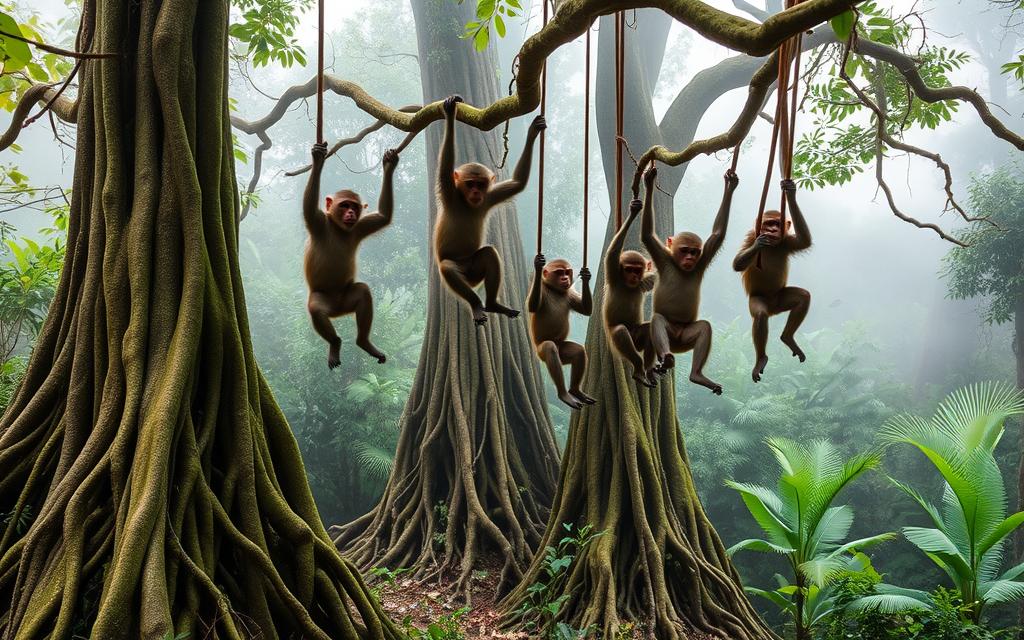
The Economy of Sacred Monkey Forest
The Sacred Monkey Forest is key to Bali’s economy, especially in Ubud. Every month, about 10,000 tourists visit, boosting the local economy. Their visits help keep the forest and its facilities running.
Revenue Generation Through Tourism
Visitors pay entry fees that help with conservation. These funds protect the forest and its animals. Sustainable tourism is pushed, helping the environment and local people.
Money also goes to community programs. These programs improve life for local people. This shows how tourism can positively affect communities.
Impact on Local Communities
The Sacred Monkey Forest creates jobs in tourism. This includes tour guides and local crafts. It gives people a way to make money.
It supports sustainable tourism and eco-friendly travel. This keeps the economy stable and preserves Balinese culture. The forest is a symbol of hope, helping local people and keeping traditions alive8910.
Cultural Importance of the Sacred Monkey Forest
The Sacred Monkey Forest is a key part of Balinese culture and traditions. It shows the deep spiritual bond locals have with nature. Here, you can see how the community respects the forest and its creatures through special rituals.
Balinese Culture and Traditions
About 93% of Bali’s people follow Balinese Hinduism. They blend their spirituality with everyday life. This place is more than a spot for tourists. It’s a center for keeping traditional practices alive, helping visitors and locals connect with their spiritual side.
The Role of Temples within the Sanctuary
Three ancient temples are inside the Sacred Monkey Forest: Pura Dalem Agung, Pura Beji, and Pura Prajapati. These temples, from the mid-14th century, link the community to their Hindu traditions. They are key in local ceremonies. Visitors can watch or join these rituals, learning about the mix of spirituality and heritage.
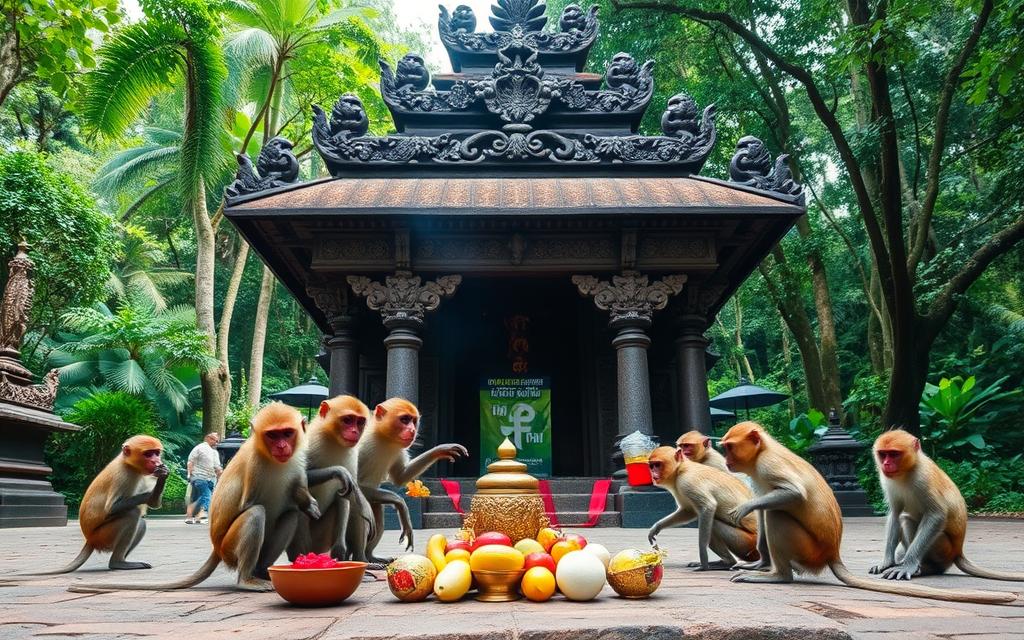
Environmental Conservation Efforts
The Sacred Monkey Forest works hard to protect the environment. It uses sustainable practices and helps protect wildlife. This place is home to over 700 monkeys, making it rich in biodiversity11. It has 186 tree species, which are key to keeping the forest healthy and safe for animals11.
Sustainable Practices in the Sanctuary
The park focuses on being kind to the environment. It has systems for managing waste and protecting natural resources. This shows how important it is to keep the monkey home safe.
Wildlife Protection Initiatives
The forest is a protected area for the long-tailed macaques. It has strict rules and teaches visitors how to be kind to the monkeys. This is important because too many visitors and pollution can harm the animals12.
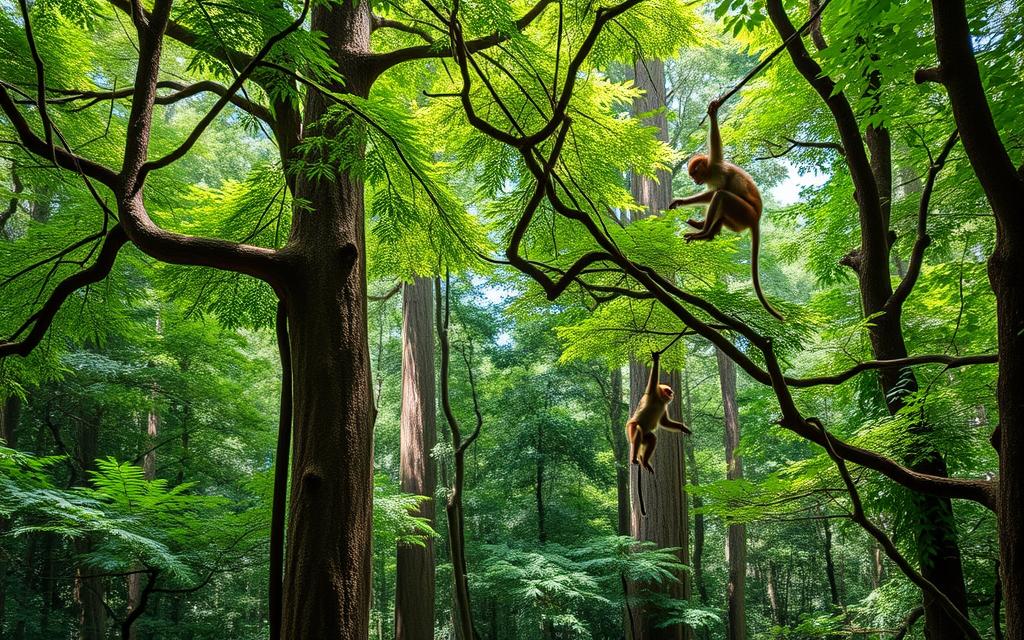
The Sanctuary uses smart marketing to help visitors respect the local culture and animals. This shows a big commitment to saving the monkeys and their home for the future13.
Tourist Attractions and Activities
The Sacred Monkey Forest has many attractions to make your visit special. Watching the monkeys is a top activity. You can see Balinese long-tailed macaques play and socialize in their home.
This lets you get close and learn about these amazing animals. You must follow rules to keep everyone safe, including the monkeys.
Monkey Observation: A Unique Experience
Watching the monkeys is fun and teaches you a lot. There are signs around that tell you about the monkeys and their world. This makes learning about them exciting and real.
Guided Tours and Educational Programs
Guided tours can make your visit even better. A guide will share stories about the forest’s culture and nature. You’ll learn why saving the forest and its animals is important.
There are also programs that let you learn by doing. They make learning about wildlife and taking care of the earth fun and interactive.
Transportation and Access to the Sacred Monkey Forest
The Sacred Monkey Forest is in Ubud and easy to get to. You can walk, take a taxi, or rent a motorbike. There are also public transport and shuttles from hotels. This makes visiting simple and stress-free.
Getting There: Various Options
Think about these ways to travel:
- Walking: If you’re in Ubud, the forest is close enough to walk to from most places.
- Taxis: Ride-hailing apps make it easy to get a taxi to the forest.
- Motorbike Rentals: Renting a motorbike lets you explore Ubud and around easily.
- Organized Shuttles: Many hotels offer shuttles straight to the forest.
Helpful Tips for Visitors
Here are tips for a great visit:
- Get there early to beat the crowds and enjoy peace.
- Buy tickets ahead of time if you can, especially when it’s busy.
- Follow the sanctuary’s rules on safely interacting with the monkeys.
- Drink water and wear comfy shoes for a fun walk through nature.
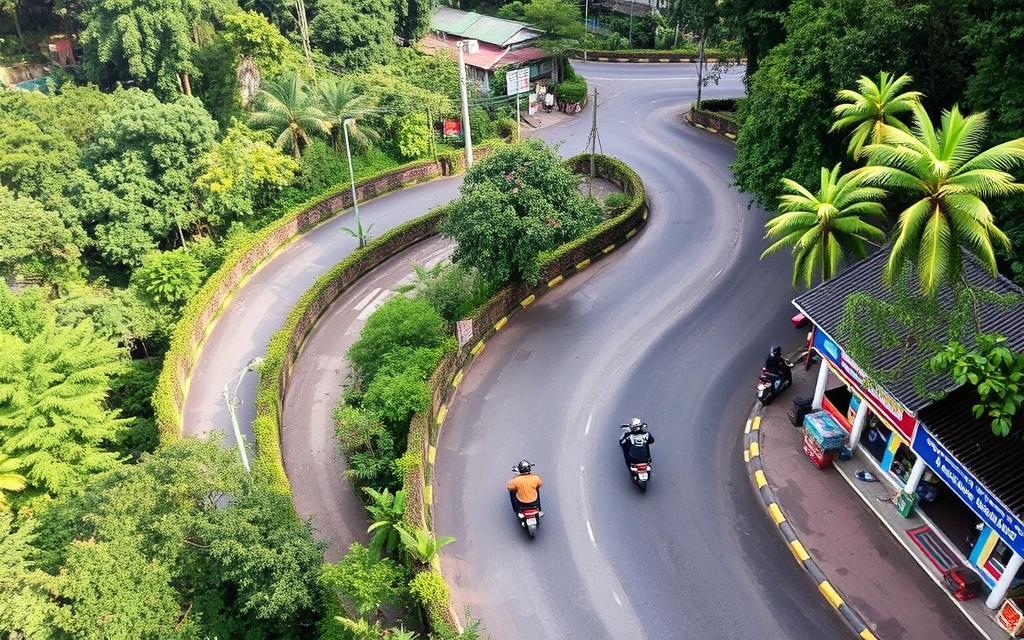
Best Time to Visit the Monkey Forest
Planning your visit to the Sacred Monkey Forest? Think about the best time. The weather and tourist numbers change with the seasons. Ubud has a wet and dry season that affects how many people come to see the monkeys.
Seasonal Considerations
The dry season, from May to September, is the best time to go. The weather is nice, making it perfect for exploring. About 10,000 tourists visit every month, with July and August being the busiest14.
Peak vs Off-Peak Tourist Seasons
Want a quiet visit? Go during the off-peak seasons. Mid-week trips in the shoulder season are peaceful. Avoid the holiday rush around Christmas and New Year for a calm visit.
Knowing when people visit helps plan your trip better. This makes your visit to the Sacred Monkey Forest more enjoyable14.
Conclusion
The Sacred Monkey Forest of Ubud shows how eco-tourism and nature can work together. When you visit, you help protect Bali’s nature and culture. It’s a place where you can see many animals and learn about taking care of the environment.
In 2023, 4.5 million tourists went to Bali, showing how important it is to visit responsibly15. The Sacred Monkey Forest is a great example of how to take care of animals and the land. Your visit helps protect endangered animals and their homes.
Going to this magical forest is more than just a trip outside. It’s a chance to help make a difference. By visiting, you support a place that cares for the earth and its creatures. You’ll make memories in a place that shows the power of caring for nature16.
FAQ
What is the Sacred Monkey Forest?
The Sacred Monkey Forest is a special place in Ubud, Bali. It’s a home for Balinese long-tailed macaques. It’s known for its beauty, culture, and many kinds of plants and animals.
How do I get to the Sacred Monkey Forest?
Getting there is easy. It’s just 2 kilometers from Ubud’s center. You can walk, drive, take a taxi, rent a motorbike, or use a shuttle from your hotel.
What should I know before visiting?
Arrive early to beat the crowds. Try to buy your tickets ahead of time. Follow the rules for meeting the monkeys to have a good visit.
When is the best time to visit the Monkey Forest?
The best time is from April to October. The weather is good for outdoor fun. You’ll see more of the forest and its animals.
Are there any guided tours available?
Yes, there are guided tours. They make your visit better by sharing the forest’s culture and how it helps animals and nature.
How does the Monkey Forest support local communities?
It helps the local economy by bringing in over 10,000 tourists every month. The money from tickets goes to protecting nature and creates jobs in tourism and crafts.
Is it safe to interact with the monkeys?
You can watch and meet the monkeys, but you must follow the rules. This keeps you safe and the monkeys happy.
What conservation efforts are in place at the Sacred Monkey Forest?
The forest uses green practices. It manages waste and protects wildlife. This keeps the place healthy for monkeys and other animals.
What are the main cultural features of the forest?
The forest has three old Hindu temples. They are Pura Dalem Agung, Pura Beji, and Pura Prajapati. These temples are very important to the Balinese culture and traditions.
What makes the Sacred Monkey Forest an eco-friendly travel destination?
It’s eco-friendly because it protects nature, helps local people, and teaches visitors to respect the environment.
Source Links
- https://www.thetravelpockets.com/new-blog/monkey-forest-ubud-bali
- https://villaamrita.com/monkey-forest-ubud-in-bali/
- https://www.kayak.com.au/Ubud.36280.guide
- https://www.tripadeal.com.au/deals/5461-best-of-bali
- https://www.indonesia.travel/nl/nl/destinations/bali-nusa-tenggara/ubud/ubud-monkey-forest.html
- https://jooi.id/travel-inspiration/discover-the-magic-of-ubud-monkey-forest-in-bali-a-comprehensive-guide
- https://traveler.byunique.com/article/38/the-sacred-monkey-forest-in-ubud
- https://ourwayoflife.co.nz/exploring-sacred-forest-ubud-bali/
- https://medium.com/live-your-life-on-purpose/is-it-possible-to-not-be-a-tourist-in-bali-91433043b11e
- https://www.jorishermans.com/blog/photo-essay-traditional-balinese-cremation
- https://medium.com/@daniela.puglisi/ubud-balis-cultural-heart-monkey-forest-tegalalang-rice-terraces-d29dfb6cb38d
- https://growfish.co/sustainable-marketing-in-bali-transforming-the-tourism-industry/
- https://www.aljazeera.com/news/2021/9/22/is-it-time-to-rethink-balis-monkey-forests
- https://www.businessinsider.com/bali-ubud-sacred-monkey-forest-2018-11
- https://www.worldanimalprotection.org/latest/blogs/bali-indonesia-wildlife-tourism/
- https://www.ncbi.nlm.nih.gov/pmc/articles/PMC10777948/